I grew up picking muscadines, a local wild grape, in the woods around my home. The table grapes from the store were nice, but nothing beats a ripe muscadine. My wife disagrees, but as I tell her, “There are two kinds of people in the world: those who love muscadines and those who are wrong.” She’s cute when she’s angry.
Anyway, let’s talk about grapes. Or rather, let’s talk about the plant as a whole. The grapevine has much more to offer besides fruit, and you might be surprised by some of its age-defying benefits.
Identification
Grape leaves come in a variety of shapes, which isn’t very sporting of them, if you ask me. They can be rounded, heart-shaped, lobed, hairy, smooth, toothed, etc. Determining the exact species can be maddening. Thankfully, grapes as a whole are easy to identify.
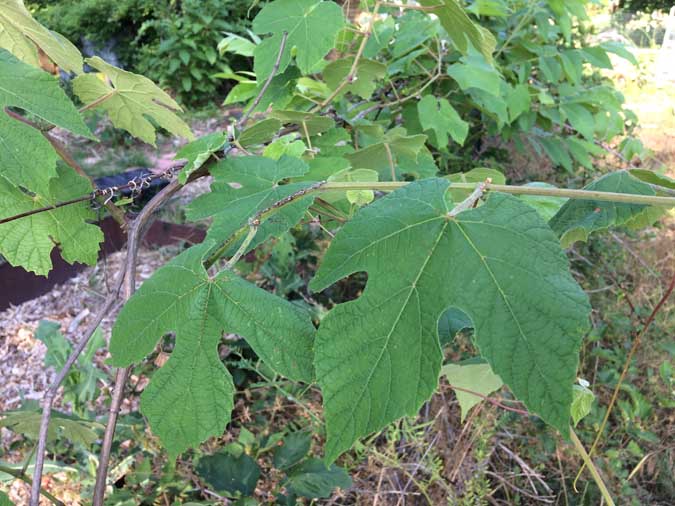
The trick here in the Ozark Mountains is to just walk uphill of a non-fruiting vine. The seed that grew it probably rolled down from the momma plant just uphill. You can often find several generations of plants that have colonized a hillside, and chances are that several of them have decided to fruit that year. But let’s get back to plant identification.
The leaves are alternate and highly variable, as mentioned above. When you find a leaf growing on one side of the stem, you’ll often find it opposite a tendril. The tendrils can be single or forked.
If you find a woody vine without tendrils, it’s not a grape. It could be the dangerous look-alike, moonseed. Another way to tell is that grapes have multiple, ovoid seeds (not counting seedless grapes), while moonseed has a single, crescent moon–shaped seed.
Grapevines are fairly adaptable, in terms of environment. Given their choice, they’ll take full sunlight, a generous amount of water, and soil with good drainage. They can be found in thickets, fencerows, woods, and forest edges. They grow in all of the contiguous United States and in the eastern half of Canada. Cultivated and wild grapes can also be found in many locations worldwide, particularly in Europe, the Middle East, and the Far East.
Edible Uses
We all know how to eat grapes. Make them into juice, jelly, wine, or raisins, or just eat them whole. Cultivated grapes are usually sweeter than their wild counterparts. Some wild grapes, however, such as my native muscadines, are especially sweet and tasty.
Grape leaves can also be eaten in a variety of ways. Raw is an option, though I find this method to be the least palatable. The young leaves are fine on a sandwich or in a salad. They could also be boiled for 10-15 minutes and served with butter. I like to add them in with a taco salad. Older leaves will need more boiling, and you will hit a point where they’re just too tough to be worth the trouble. But it’s up to you exactly when that point is.
Dolmas
The most well-known edible use of grape leaves is probably in dolmas. Dolmas are stuffed vegetable, rice, and/or meat dishes that use grape leaves as wraps. Just parboil the leaves for a minute or two. Then dip them in ice water to stop the cooking process. Now you can place a spoonful of whatever filling you like onto each leaf and wrap them up like burritos. You can eat them as they are, or place them in the oven for additional baking. Bigger leaves are a lot easier to work with here.
Leaf Chips
Another tasty option is leaf chips. Preheat your oven to 350°F (175°C). Place your grape leaves in a bowl and lightly coat them with olive oil. Next, spread them out on a baking sheet and sprinkle with salt, pepper, or the seasoning of your choice. Place them in the oven and let them cook for about 10 minutes. Give it a try.
The seeds can be pressed for their oil, which is edible and also used in herbal skin applications. Infused grape-seed oil is considered fairly ideal for already oily or blemished skin. It is absorbed quickly and leaves no oily residue.
The sap is edible as well. It could just be a lifesaver if you’re ever lost in the woods and in need of a clean water source.
Medicinal Uses
Resveratrol
Now we get to the really exciting part. In terms of medical properties, grapevines are a veritable fountain of youth. In particular, the chemical resveratrol can help to prevent almost all age-related chronic diseases, and may render many chronic diseases—such as cardiovascular disease, dementia, Type 2 diabetes, and osteo-arthritis—reversible.1)Mills, Simon, and Kerry Bone. Principles and Practice of Phytotherapy: Modern Herbal Medicine. Edinburgh: Churchill Livingstone, 2013.2)Grossberg, George T., and Barry Fox. The Essential Herb-drug-vitamin Interaction Guide: The Safe Way to Use Medications and Supplements Together. New York: Broadway Books, 2007.
In one study, middle-aged male mice were fed a high-calorie diet, and were then given resveratrol. While the resveratrol did not keep them from gaining weight or help them lose weight, it did protect them from the negative effects associated with the weight gain. And not only were they protected from weight- and age-associated health problems, but also their health and mobility steadily improved until their test results were within the same range as the control group of normally fed mice.3)Mills, Simon, and Kerry Bone. Principles and Practice of Phytotherapy: Modern Herbal Medicine. Edinburgh: Churchill Livingstone, 2013.
Resveratrol seems to be able to mimic the effects of a calorie-restrictive diet, tricking our bodies into aging more slowly.4) Mills, Simon, and Kerry Bone. Principles and Practice of Phytotherapy: Modern Herbal Medicine. Edinburgh: Churchill Livingstone, 2013. The science on this isn’t completely settled, though it is a very encouraging idea.
Cancer
Resveratrol also has some rather promising anti-cancer properties, particularly as a preventative. It has been shown to interfere with the three major stages of tumor formation—initiation, promotion, and progression.5)Mills, Simon, and Kerry Bone. Principles and Practice of Phytotherapy: Modern Herbal Medicine. Edinburgh: Churchill Livingstone, 2013.6)Hoffmann, David. Medical Herbalism: The Science and Practice of Herbal Medicine. Rochester, VT: Healing Arts Press, 2003. In particular, resveratrol has been associated with a significantly lower risk of prostate cancer.7)Mills, Simon, and Kerry Bone. Principles and Practice of Phytotherapy: Modern Herbal Medicine. Edinburgh: Churchill Livingstone, 2013.
Oligomeric Procyanidins
While resveratrol gets most of the glory, grapes produce a number of health-supporting compounds, such as oligomeric procyanidins (OPCs). OPCs are highly antioxidant—many times more powerful than vitamins C and E.8)Elpel, Thomas J. Botany in a Day: Thomas J. Elpels Herbal Field Guide to Plant Families. Pony, MT: HOPS Press, 2004.
These compounds are commercially extracted from seeds. However, they are 10-100 times more abundant in the leaves. And why buy a supplement when you can pick a leaf?
By the way, OPCs are especially antiviral toward dengue.9)Buhner, Stephen Harrod. Herbal Antivirals: Natural Remedies for Emerging Resistant & Epidemic Viral Infections. North Adams, MA: Storey Publishing, 2013. So just tuck that little tidbit away in the event that you spend some time in a tropical region.
Circulatory System
The Vitis genus also seems to have a special affinity for the circulatory system. Many of its effects may be linked, directly or indirectly, to this affinity. It helps to regulate blood sugar levels, prevent blood clots, prevent and repair varicose veins, treat hemorrhoids, and protect against atherosclerosis.10)Mills, Simon, and Kerry Bone. Principles and Practice of Phytotherapy: Modern Herbal Medicine. Edinburgh: Churchill Livingstone, 2013.11)Grossberg, George T., and Barry Fox. The Essential Herb-drug-vitamin Interaction Guide: The Safe Way to Use Medications and Supplements Together. New York: Broadway Books, 2007.12)Johnson, Rebecca L., Steven Foster, and Andrew Weil. National Geographic Guide to Medicinal Herbs: The Worlds Most Effective Healing Plants. Washington, D.C.: National Geographic, 2014.
It also supports and protects the microvascular systems of the body, such as the delicate blood vessels in the eyes and fragile capillaries throughout the body. This circulation enhancement is used to treat macular degeneration and eye strain, and may help to prevent cataracts.13) Grossberg, George T., and Barry Fox. The Essential Herb-drug-vitamin Interaction Guide: The Safe Way to Use Medications and Supplements Together. New York: Broadway Books, 2007.14)Elpel, Thomas J. Botany in a Day: Thomas J. Elpels Herbal Field Guide to Plant Families. Pony, MT: HOPS Press, 2004.15)Johnson, Rebecca L., Steven Foster, and Andrew Weil. National Geographic Guide to Medicinal Herbs: The Worlds Most Effective Healing Plants. Washington, D.C.: National Geographic, 2014. Increased circulation to the brain may explain the neuroprotective benefits, such as its potential to help improve and prevent Alzheimer’s disease.16)Ma, Teng, Meng-Shan Tan, Jin-Tai Yu, and Lan Tan. Advances in Pediatrics. 2014. Accessed May 23, 2018. https://www.ncbi.nlm.nih.gov/pmc/articles/PMC4261550/.17)Elpel, Thomas J. Botany in a Day: Thomas J. Elpels Herbal Field Guide to Plant Families. Pony, MT: HOPS Press, 2004.
Connective Tissue
Grapes and grape leaves strengthen, stabilize, and repair connective tissue throughout the body and have been used to help strengthen the intestinal walls to prevent or stabilize diverticular disease.18)Mills, Simon, and Kerry Bone. Principles and Practice of Phytotherapy: Modern Herbal Medicine. Edinburgh: Churchill Livingstone, 2013.19)Grossberg, George T., and Barry Fox. The Essential Herb-drug-vitamin Interaction Guide: The Safe Way to Use Medications and Supplements Together. New York: Broadway Books, 2007. They also help to prevent bruising, particularly in the elderly.20)Foster, Steven, James A. Duke, and Steven Foster. A Field Guide to Medicinal Plants and Herbs of Eastern and Central North America. Boston: Houghton Mifflin, 2000. This may be related to the plant’s circulatory effects, connective tissue effects, or a combination of both.
Antimicrobial
Compounds within the grape plant also have selective antimicrobial properties—a dampening effect on pathogenic bacteria—while having only a minimal effect on healthy gut flora.21)Mills, Simon, and Kerry Bone. Principles and Practice of Phytotherapy: Modern Herbal Medicine. Edinburgh: Churchill Livingstone, 2013. They also have some antiviral properties, especially toward dengue, as mentioned above.22)Buhner, Stephen Harrod. Herbal Antivirals: Natural Remedies for Emerging Resistant & Epidemic Viral Infections. North Adams, MA: Storey Publishing, 2013.
Other Properties
The leaves are astringent, anti-inflammatory, and help with asthma and allergies by reducing histamine production.23)Grossberg, George T., and Barry Fox. The Essential Herb-drug-vitamin Interaction Guide: The Safe Way to Use Medications and Supplements Together. New York: Broadway Books, 2007.24)Chevallier, Andrews. Encyclopedia of Herbal Medicine. DK, 2000.25)Johnson, Rebecca L., Steven Foster, and Andrew Weil. National Geographic Guide to Medicinal Herbs: The Worlds Most Effective Healing Plants. Washington, D.C.: National Geographic, 2014. Leaf tea has traditionally been used for diarrhea, stomachache, thrush, hepatitis, and uterine bleeding.26)Chevallier, Andrews. Encyclopedia of Herbal Medicine. DK, 2000.27)Foster, Steven, James A. Duke, and Steven Foster. A Field Guide to Medicinal Plants and Herbs of Eastern and Central North America. Boston: Houghton Mifflin, 2000. Leaves have also been used as a poultice for rheumatism, headaches, fevers, and blisters on the feet.28)Chevallier, Andrews. Encyclopedia of Herbal Medicine. DK, 2000.29)Foster, Steven, James A. Duke, and Steven Foster. A Field Guide to Medicinal Plants and Herbs of Eastern and Central North America. Boston: Houghton Mifflin, 2000.
Selecting Grapes
Medicinal properties tend to be stronger in grape varieties with darker fruit, though exceptions exist and growing conditions can also have an effect. Resveratrol production, for example, is greater in grapes that have had to endure a fungal attack.30)Mills, Simon, and Kerry Bone. Principles and Practice of Phytotherapy: Modern Herbal Medicine. Edinburgh: Churchill Livingstone, 2013. Grapes that have been treated heavily with pesticides, such as most store-bought grapes, have fewer medicinal benefits.31)Magee, J.B. “J.B. Magee.” HortScience. April 01, 2002. Accessed May 23, 2018. http://hortsci.ashspublications.org/content/37/2/358.short.
Resveratrol is usually associated with the skin of grapes, where it tends to be the most concentrated. However, resveratrol can also be found in significant quantities in the leaves, though this, too, depends on variety and growing conditions.
Method and Dosage
While the fruit gets the most glory, grape leaves contain the same medicinal compounds in varying proportions. Use whichever you prefer or whichever is available.
The leaves can be eaten directly or used in infusions or tinctures. Grapes are most famously used in wine, though juice can be used fairly interchangeably. The juice may even have longer-lasting antioxidant protection.32)Johnson, Rebecca L., Steven Foster, and Andrew Weil. National Geographic Guide to Medicinal Herbs: The World’s Most Effective Healing Plants. Washington, D.C.: National Geographic, 2014.
Due to the variability between grape varieties and species, recommending a standard dosage is problematic. This is one place where standardized supplements have an advantage over wildcrafting. My best advice would be to listen to your body. Try a bit every day and see how you feel in a couple of weeks. Up the amount as needed.
Also, resveratrol metabolizes quickly, so more frequent doses may be advisable. And, no, I’m not giving you permission to drink all the wine you want. A little wine is fine, but remember the non-alcoholic sources, as well.
Lastly, for maximum medicinal effect, consume grape products separately from fatty meals. Fats significantly reduce the bioavailability of resveratrol.33)Mills, Simon, and Kerry Bone. Principles and Practice of Phytotherapy: Modern Herbal Medicine. Edinburgh: Churchill Livingstone, 2013.
Caution
When combined with blood-thinning medications, grapes may increase the bleeding risks.34)Grossberg, George T., and Barry Fox. The Essential Herb-drug-vitamin Interaction Guide: The Safe Way to Use Medications and Supplements Together. New York: Broadway Books, 2007.
I hope you’ll be motivated to ditch the pesticide-laden, store-bought grapes and grow some of your own.
Are you already growing grapes, or do you have any wild vines nearby? Let me know in the comments!
_______________________________________________________
Psst! Our Lawyer Wants You to Read This Big, Bad Medical Disclaimer –> The contents of this article, made available via The Grow Network (TGN), are for informational purposes only and do not constitute medical advice; the Content is not intended to be a substitute for professional medical advice, diagnosis, or treatment. Always seek the advice of a qualified health care provider with any questions you may have regarding a medical condition. If you think you may be suffering from any medical condition, you should seek immediate medical attention. You should never delay seeking medical advice, disregard medical advice, or discontinue medical treatment because of information provided by TGN. Reliance on any information provided by this article is solely at your own risk. And, of course, never eat a wild plant without first checking with a local expert.
_______________________________________________________

Scott Sexton is a TGN Trailblazer, a highly experimental gardener, an unrelenting weed-eater, and a largely non-profit herbalist (much to his wife’s chagrin). When Scott is not teaching foraging classes, testing out theories in the garden, or grazing in the forest, he can be found at his Facebook page, “A Forager’s Guide to the Zombie Apocalypse.”
References
| ↑1, ↑3, ↑5, ↑7, ↑10, ↑18, ↑21, ↑30, ↑33 | Mills, Simon, and Kerry Bone. Principles and Practice of Phytotherapy: Modern Herbal Medicine. Edinburgh: Churchill Livingstone, 2013. |
|---|---|
| ↑2, ↑11, ↑19, ↑23, ↑34 | Grossberg, George T., and Barry Fox. The Essential Herb-drug-vitamin Interaction Guide: The Safe Way to Use Medications and Supplements Together. New York: Broadway Books, 2007. |
| ↑4 | Mills, Simon, and Kerry Bone. Principles and Practice of Phytotherapy: Modern Herbal Medicine. Edinburgh: Churchill Livingstone, 2013. |
| ↑6 | Hoffmann, David. Medical Herbalism: The Science and Practice of Herbal Medicine. Rochester, VT: Healing Arts Press, 2003. |
| ↑8, ↑14, ↑17 | Elpel, Thomas J. Botany in a Day: Thomas J. Elpels Herbal Field Guide to Plant Families. Pony, MT: HOPS Press, 2004. |
| ↑9, ↑22 | Buhner, Stephen Harrod. Herbal Antivirals: Natural Remedies for Emerging Resistant & Epidemic Viral Infections. North Adams, MA: Storey Publishing, 2013. |
| ↑12, ↑15, ↑25 | Johnson, Rebecca L., Steven Foster, and Andrew Weil. National Geographic Guide to Medicinal Herbs: The Worlds Most Effective Healing Plants. Washington, D.C.: National Geographic, 2014. |
| ↑13 | Grossberg, George T., and Barry Fox. The Essential Herb-drug-vitamin Interaction Guide: The Safe Way to Use Medications and Supplements Together. New York: Broadway Books, 2007. |
| ↑16 | Ma, Teng, Meng-Shan Tan, Jin-Tai Yu, and Lan Tan. Advances in Pediatrics. 2014. Accessed May 23, 2018. https://www.ncbi.nlm.nih.gov/pmc/articles/PMC4261550/. |
| ↑20, ↑27, ↑29 | Foster, Steven, James A. Duke, and Steven Foster. A Field Guide to Medicinal Plants and Herbs of Eastern and Central North America. Boston: Houghton Mifflin, 2000. |
| ↑24, ↑26, ↑28 | Chevallier, Andrews. Encyclopedia of Herbal Medicine. DK, 2000. |
| ↑31 | Magee, J.B. “J.B. Magee.” HortScience. April 01, 2002. Accessed May 23, 2018. http://hortsci.ashspublications.org/content/37/2/358.short. |
| ↑32 | Johnson, Rebecca L., Steven Foster, and Andrew Weil. National Geographic Guide to Medicinal Herbs: The World’s Most Effective Healing Plants. Washington, D.C.: National Geographic, 2014. |
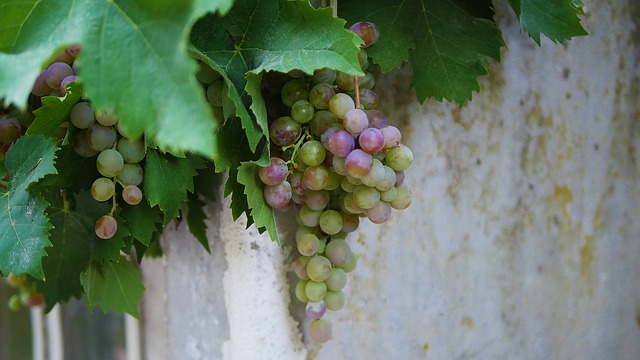
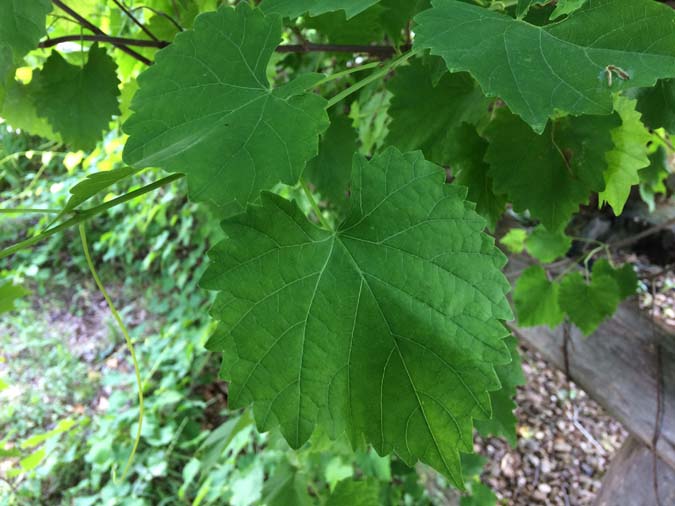
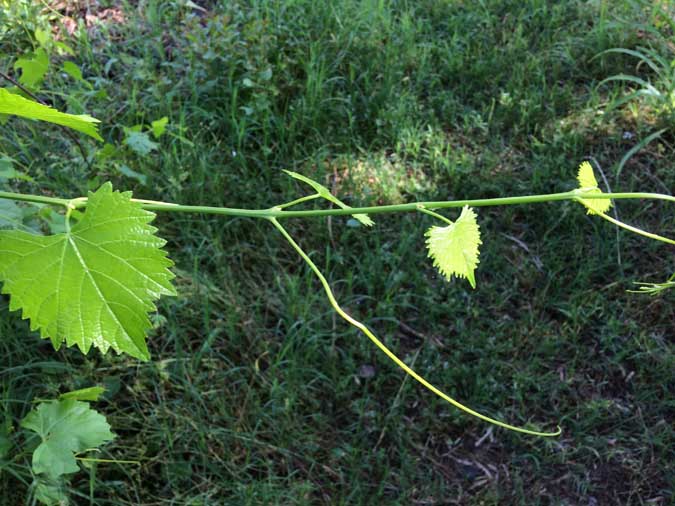
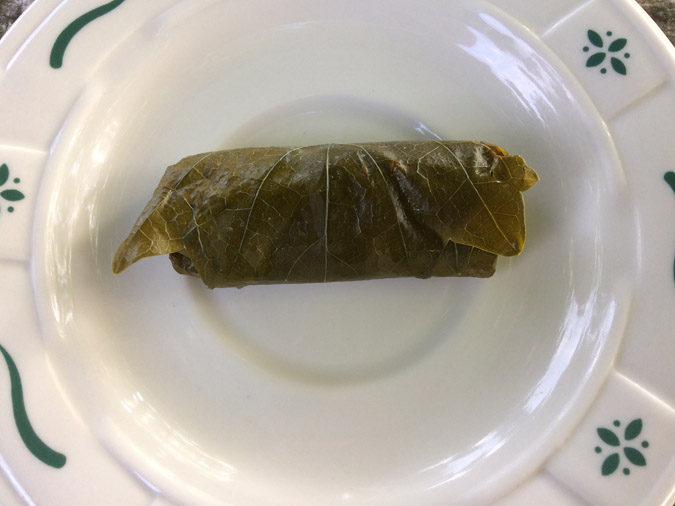
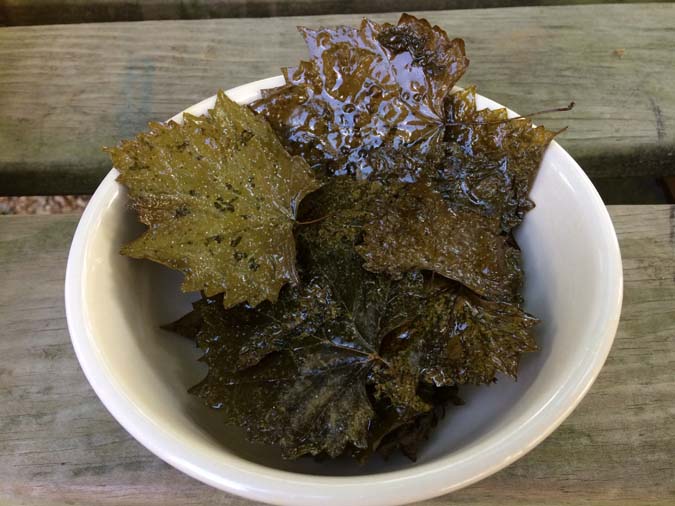








COMMENTS(11)
I had plenty of wild grapes growing around me in Minnesota, and I harvested them. There are wild grapes growing here in West Virginia as well.
That’s great to hear. How do they taste? A lot of the wild grapes around me (except muscadines) are fairly unpalatable.
YES!
i have lots of wild grapes here and allow them to drape into grape arbors, two years ago these vines offered us delicious black grapes, not many but what appeared were very tasty bites, last year NO grapes at all. This year seems like a kinder year weather wise so hopefully i will have lots of grapes.
Your article is a delight, so much information. no idea i could just pluck off these wild grape leaves and eat them and even bake them….i will definitely try this. but first a question: are all wild grapes and grape leaves edible? we are in upstate new york. Would appreciate any warnings if appropriate.
thank you so much for this very fun and immediately useful information!!!
Lhamo
I love a good grape arbor. We got a long outdoor “hallway” covered by muscadine grapes. It’s nice and shady on hot summer days. I’ve been thinking of putting a bench or two out there for relaxing.
Anyway, yes. If you’re sure you’re looking at a grape plant, it’s edible. But it may not be palatable.
Muscadines grow like weeds here… will have to add a couple of leaves to my next smoothie!
Muscadines are my absolute favorites. I’d pick them over store grapes any day. I’ve always heard (and believe) that muscadine leaves have the highest concentration of resveratrol. But I didn’t include it in the article because I couldn’t find a good, authoritative source for it. Still…food for thought.
I grew up eating them from my grandmother’s vines, but we always had to watch for snakes under the massive trellis. I now have two scuppernongs and two muscadines that do a lovely job of feeding the neighborhood raccoons. I think I’ve eaten one or two from the vines. Consider yourself lucky to find them in the wild!
That’s interesting. I’ve never had trouble with raccoons or snakes, though I have had trouble with wasps nesting in the shelter of the vines. I’ve also had birds nest in my vines a couple of times. Back when I was trying to free range my chickens, they took up temporary residence in my muscadine arbor. It was a pretty nice spot for them, as far as it goes.
Wow! Now I REALLY want to start some grapes. Thanks!
Let us know how it goes!
I just left the store this morning with 2 muscadine plants and a sunbelt concord. I’m looking forward to seeing how they grow. Thanks!